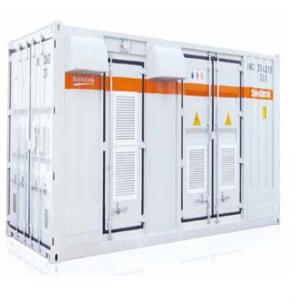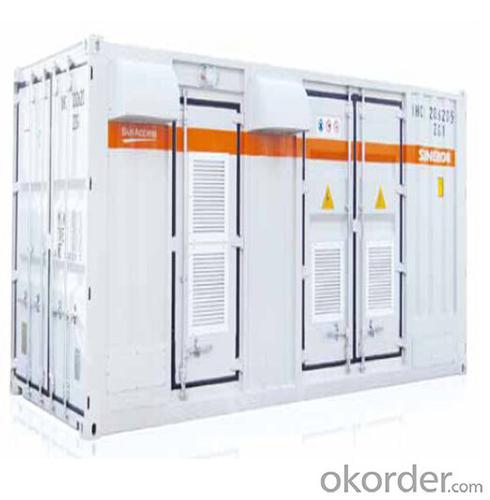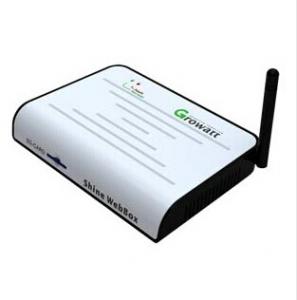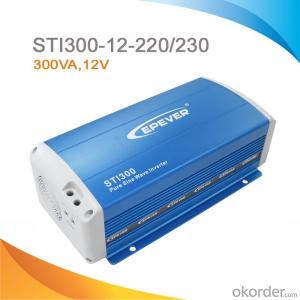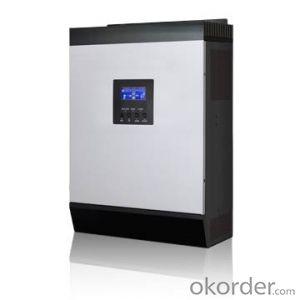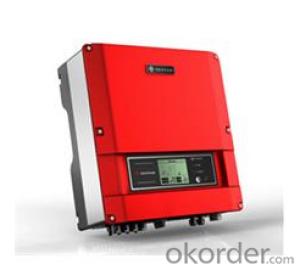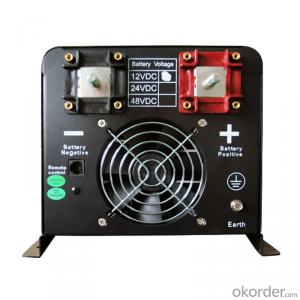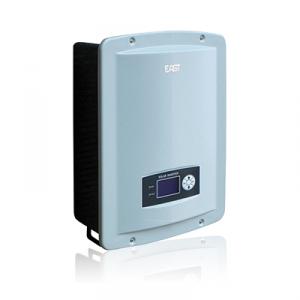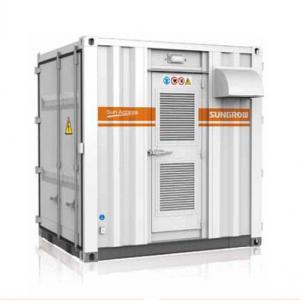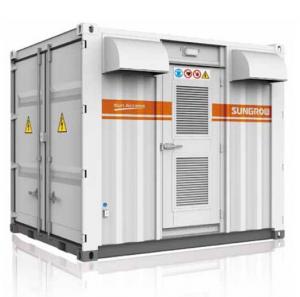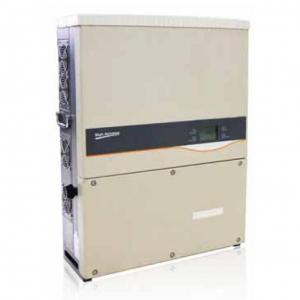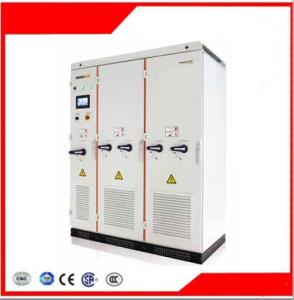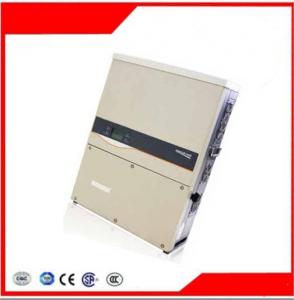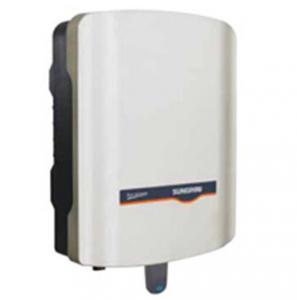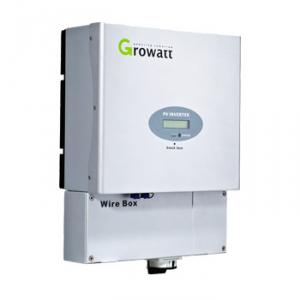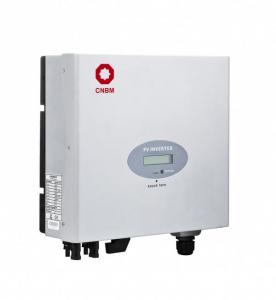Solar Inverter 5000W Photovoltaic Grid-Connected Inverter SG1000TS-MV
- Loading Port:
- China Main Port
- Payment Terms:
- TT or LC
- Min Order Qty:
- 50 unit
- Supply Capability:
- 1000 unit/month
OKorder Service Pledge
OKorder Financial Service
You Might Also Like
1. Structure of Photovoltaic Grid-Connected Inverter SG1000TS-MV Description
A solar inverter, or PV inverter, or Solar converter, converts the variable direct current (DC) output of a photovoltaic (PV) solar panel into
autility frequency alternating current (AC) that can be fed into a commercial electrical grid or used by a local, off-grid electrical network.
It is acritical BOS–component in a photovoltaic system, allowing the use of ordinary AC-powered equipment. Solar inverters have
special functions adapted for use with photovoltaic arrays, including maximum power point tracking and anti-islanding protection.
Suitable for 50Hz/60Hz grid, could be used in Asia, North America and Europe.
2. Main Features of the Photovoltaic Grid-Connected Inverter SG1000TS-MV
• Turn-key solution,high integration
• Integrated PV inverter, DC/AC power distribution, medium-voltage transformer, system monitoring, fire alarm, environment monitoring functional modules and so on
• Save AC cables, lower consumption and promote users’ benefits
• SCADA monitoring system integrated to reduce the costs and ensure the optimal status of the plant
* Easy for Transportation and Handling, Environment Adaptable
• Container design, easy for transportation
• Integral hoisting, easy to install, reduce the installation cost and risks.
• Standard container enclose, integrated design for ventilation, sandproof, anti-corrosion and anti-low-temperature and other application requirements.
* Advanced Technology, Grid-friendly
• Efficiency, energy-saving and reliability as with all Sungrow inverters
• Integrated with standard power dispatch interfaces, convenient and flexible access to power grid;
• LVRT (Zero-voltage Ride-through), Reactive power control with power factor from 0.9 lagging to 0.9 leading, Give reactive power compensation to the grid at night according to directive
3. Photovoltaic Grid-Connected Inverter SG1000TS-MV Images
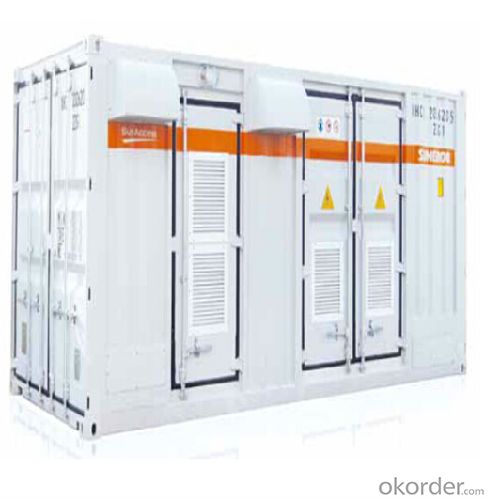

4. Photovoltaic Grid-Connected Inverter SG1000TS-MV Specification
Side Data | |
Max. DC power (@ cos φ =1) | 1120kW |
Max. input voltage | 1000V |
Start voltage | 500V |
Min. working voltage | 460V |
Max. input current | 2440A |
MPPT voltage range | 460~850V |
Number of DC inputs | 16/32 |
Output Side Data | |
Rated power | 1000kW |
Max. output AC power | 1100kVA |
Max. output current | 63.5A |
Max. THD | <3%(at nominal power) |
Rated grid voltage | 10-24kV |
Rated grid frequency | 50Hz / 60Hz |
Grid frequency range | 47~52Hz / 57 ~62Hz |
Power factor at rated power | >0.99 |
DC current injection | <0.5% of rated inverter output current |
Adjustable displacement factor | 0.9 (lagging) ~0.9 (leading) |
Efficiency | |
Max. efficiency | 98.00% |
European efficiency | 97.50% |
Protection | |
DC input side disconnection device | Switch-disconnector with fuses |
AC output side disconnection device | Switch-disconnector with fuses |
DC overvoltage protection | Yes |
AC overvoltage protection on the LV side | Yes |
Grid monitoring | Yes |
Ground fault monitoring | Yes |
Overheat protection | Yes |
Insulation monitoring | Yes |
General Data | |
Dimensions(W×H×D) | 6058x2591x2438mm |
Weight | 12T |
Operating temperature range | -35~50℃ |
External auxiliary supply voltage (Opt.) | 380V |
Cooling concept | Temperature controlled air-cooling |
Degree of protection | IP54 |
Max. permissible value for relative humidity (non-condensing) | 0~95%, non -condensing |
Max. altitude | 6000m (derating > 3000m) |
Communication port/protocols | Standard: RS485/ Modbus, Internet |
Options: CDT, DNP3.0, 101, 103, 104, GPRS/CDMA module | |
5. FAQ of Photovoltaic Grid-Connected Inverter SG1000TS-MV
Q1. What is the difference between inverter and solar inverter?
A1. Inverter only has AC inpput, but solar inverter both connect to AC input and solar panel, it saves more power.
Q2. What is the difference between MPPT&PWM?
A2. MPPT has higher efficiency, it can track the max power point and won't waste energy.
- Q: How is the efficiency of a solar inverter measured?
- The efficiency of a solar inverter is typically measured by dividing the output power of the inverter by the input power, and then multiplying the result by 100 to get a percentage value.
- Q: How does a solar inverter prevent reverse current flow?
- A solar inverter prevents reverse current flow by using built-in diodes that act as one-way valves, allowing electricity to flow only in the desired direction from the solar panels to the grid or battery system.
- Q: How does a solar inverter handle voltage fluctuation during cloud cover?
- A solar inverter handles voltage fluctuation during cloud cover by continuously monitoring and adjusting the output voltage to compensate for the reduced solar energy input. This is typically achieved through advanced control algorithms that optimize the inverter's power output to maintain a stable voltage level, ensuring a smooth transition during periods of cloud cover and minimizing any disruptions to the electrical system.
- Q: How does a solar inverter handle low light conditions or cloudy days?
- A solar inverter handles low light conditions or cloudy days by continuously monitoring the incoming solar energy. When there is a decrease in sunlight, the inverter adjusts its voltage and current output to optimize the power conversion. This ensures that even under low light conditions, the inverter can still convert the available solar energy into usable electricity efficiently.
- Q: Can a solar inverter be used with a three-phase power system?
- Yes, a solar inverter can be used with a three-phase power system. In fact, most modern solar inverters are designed to work with both single-phase and three-phase power systems.
- Q: Can a solar inverter be used in systems with different module tilts?
- Yes, a solar inverter can be used in systems with different module tilts. Solar inverters are designed to convert the DC power generated by solar panels into AC power for use in the electrical grid or in the building. The module tilt refers to the angle at which the solar panels are installed, which can vary depending on factors like geographical location and specific installation requirements. Solar inverters are typically designed to be adaptable and can accommodate a wide range of module tilts, allowing for flexibility and optimization of solar energy generation.
- Q: What is the role of ground fault protection in a solar inverter?
- The role of ground fault protection in a solar inverter is to detect and mitigate any potential faults or abnormalities in the system's grounding. It ensures the safety of the system and personnel by quickly identifying and isolating ground faults, preventing electrical shock hazards and damage to the equipment.
- Q: Can a solar inverter be used with solar-powered telecommunications systems?
- Yes, a solar inverter can be used with solar-powered telecommunications systems. A solar inverter is an essential component that converts the direct current (DC) generated by solar panels into alternating current (AC) that is required to power telecommunication equipment. This allows for efficient utilization of solar energy in telecommunications systems, making them more sustainable and independent from the grid.
- Q: Can a solar inverter be used with a solar-powered food dehydrator?
- Yes, a solar inverter can be used with a solar-powered food dehydrator. The solar inverter helps convert the direct current (DC) produced by the solar panels into alternating current (AC) that can be used by the food dehydrator. This allows the dehydrator to operate using the energy generated by the solar panels, making it an efficient and sustainable option for food dehydration.
- Q: Can a solar inverter be used for both residential and commercial applications?
- Yes, a solar inverter can be used for both residential and commercial applications. Solar inverters are designed to convert the direct current (DC) electricity generated by solar panels into alternating current (AC) electricity, which is suitable for use in homes and businesses. They are versatile and can be scaled up or down depending on the size of the solar power system, making them suitable for both residential and commercial installations.
Send your message to us
Solar Inverter 5000W Photovoltaic Grid-Connected Inverter SG1000TS-MV
- Loading Port:
- China Main Port
- Payment Terms:
- TT or LC
- Min Order Qty:
- 50 unit
- Supply Capability:
- 1000 unit/month
OKorder Service Pledge
OKorder Financial Service
Similar products
Hot products
Hot Searches
Related keywords
